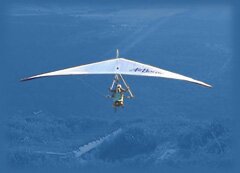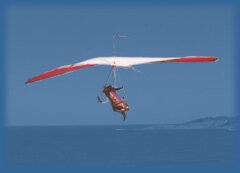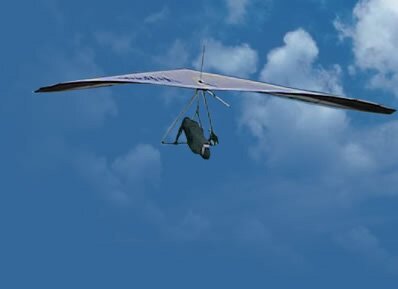|
||||

Is hanggliding physically demanding?Almost anyone can fly a hanglider. While flying does not require great strength (since the straps - not the pilot's arms - hold the pilot up), long duration flights in turbulent conditions require a moderate degree of upper body endurance. This typically develops as the pilot progresses through training to these longer flights. Do pilots need to be of a certain age, gender, and weight or size range?Hangglider pilots range in age from teens to octogenarians. The limits are more mental than physical. If someone is sufficiently mature to make decisions significantly affecting their safety and has sufficiently good reflexes to make such decisions promptly, then they probably are of a reasonable age for flying. Since flying depends more on balance and endurance than on brute strength, woman and men make equally good pilots. While the fraction varies regionally, about 10 - 15 % of the hanglider pilots in the US are women. Do pilots need to be licensed to fly hanggliders?Not really, but a program analogous to FAA licensing exists and is administered by the USHGA (US Hanggliding Association). This program consists of a specific set of flying skills corresponding to a series of pilot proficiency ratings (Beginner through Master) each of which carries a set of recommended operating limitations. Beginner rated pilots, for instance, should only fly from hills under 100 ft in height in mild winds and under the guidance of an instructor. While these ratings don't carry the force of law in quite the same way as FAA pilot's licenses do, the majority of flying sites in the US require that pilots hold some specific USHGA rating to be allowed to fly solo.How does a student go about learning to fly? In the USA, the USHGA certifies hangliding instructors and schools. One of the major reasons hangliding is safer now than 20 years ago is this certification program and all students should thus learn from a certified instructor. All 1-800-SKYRIDE Center instructors are USHGA certified. In the USA, the USHGA certifies hangliding instructors and schools. One of the major reasons hangliding is safer now than 20 years ago is this certification program and all students should thus learn from a certified instructor. All 1-800-SKYRIDE Center instructors are USHGA certified.
The time required for training varies considerably with the student's innate skills and with the type of training conditions. Typically, though, a student will spend 5 - 10 lessons to obtain each of the first two USHGA pilot ratings (Beginner and Novice) - a process which generally takes from 3 to 6 months. At the end of this primary training process, the student is usually flying from moderate altitudes (several hundred to a few thousand ft) in relative mild conditions. Progression to more difficult flying conditions continues from then on under the supervision of more experienced pilots or Observers/Advanced Instructors. How high/far can a hangglider go?This depends a lot on the conditions in which it is flown, but flights in excess of 300 miles in length and altitudes of well over 20,000 ft. MSL have been recorded. More typically, pilots in the summer frequently achieve altitudes of 5,000 to 10,000 ft AGL and fly for over 100 miles. How long do flights last?Again this depends on conditions, but a high altitude flight is frequently several hours in duration. On good days, pilots don't have to land until the sun goes down. Where can gliders launch and land?Pretty much any slope that is relatively free from obstructions, is steeper than about 6 to 1 and faces into the wind can be used to foot launch a hanglider. The pilot just runs down the slope and takes off when the air speed reaches 15 to 20 mph. Alternatively, when no hills are available, towing by trucks, stationary winches and ultralight aircraft allows gliders to get into the air . Where a hangglider can be landed depends somewhat on the skill of the pilot. An experienced pilot should be able to put a glider safely into any flat spot bigger than about 50 by 200 ft and clear of obstructions. This area requirement can vary somewhat, though, depending on wind conditions and the surrounding terrain. How safe are hangliders?Hanggliding can be a very safe sport! Gliders in the US are now certified for airworthiness by the Hangglider Manufacturers Assn. (HGMA), so structural failures on recent equipment flown within its placarded limits are a thing of the past. In addition, reserve parachutes are used on all high altitude hanglider flights now, and provide a measure of safety in the rare instances of severe glider damage or complete loss of control. Also, hanggliding instruction has been standardized and most students learn from certified instructors using a thorough, gradual training program. So the days of untrained pilots trying unsafe maneuvers at dangerous sites are also largely gone. Safety is the number one priority with ALL 1-800-SKYRIDE Centers, so you can feel confident knowing that all measures are taken to ensure that you have the safest, most thrilling experience possible! How do you steer?
Hanggliders are controlled by shifting the pilot's weight with respect to the glider. Pilots are suspended from a strap connected to the glider's frame (hence the name "hang" glider). By moving forward and backward and side to side at the end of this strap, the pilot alters the center of gravity of the glider. This then causes the glider to pitch or roll in the direction of the pilot's motion and thus allows both speed control and turning. Is lots of wind necessary to launch/fly/land?Hanggliders can be launched, flown and landed in winds from zero to about 30 mph safely. When winds get above about 40 mph, the associated turbulence makes all aspects of flight substantially less comfortable. Generally, ideal winds for launching and landing are from 5 to 20 mph depending on the flying site. Wind speed is less important in flight since the pilot controls the air speed of the glider whatever the wind speed may be. How do gliders gain altitude?In addition to the horizontal wind we're accustomed to on the ground, air moves vertically as well. If a glider encounters a rising chunk of air, it will go up along with it. The whole trick of soaring a hangglider (or any other glider for that matter) is to figure out where the air is going up and then to get there. While there are many sources of rising air or "lift", the most commonly used by hanggliders are ridge lift and thermal lift. Ridge lift occurs when horizontal wind hits an obstruction (like a ridge, for instance) and is deflected upward. Thermal lift occurs when terrain is heated by the sun and transfers this heat to the surrounding air - which then rises. Typically ridge lift exists in a "lift band" on the windward side of a ridge and pilots get up by flying back and forth through this band. Thermal lift on the other hand usually starts at some local "trigger point" on the ground and then rises as a column or bubble of air. To get up in a thermal, pilots typically circle in this region of rising air. What range of temperatures are encountered in flight?Hanggliders are flown in sub-zero conditions in the winter and in the hottest deserts in the summer. Since the air temperature typically falls by about 4 degrees (F) for every 1000 ft gain in elevation, however, high altitude hangglider flights are frequently cold. Pilots expecting to fly over about 12 - 14,000 ft in the summer will generally wear warm clothing to protect against exposure. |
|



